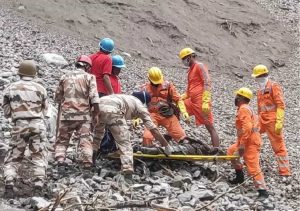 Landslides are natural disasters that pose a significant threat to human lives, property, and infrastructure. These sudden, destructive events can be triggered by heavy rainfall, earthquakes, or other geological factors. Landslide rescue operations are complex and challenging, requiring specialized skills, equipment, and coordination among response agencies and local communities. This brief write-up explores the critical aspects of landslide rescue operations, focusing on preparedness, rapid response, and risk mitigation measures. From search and rescue techniques to community engagement, we delve into the strategies that enable responders to save lives and support affected communities during and after a landslide.
Landslides are natural disasters that pose a significant threat to human lives, property, and infrastructure. These sudden, destructive events can be triggered by heavy rainfall, earthquakes, or other geological factors. Landslide rescue operations are complex and challenging, requiring specialized skills, equipment, and coordination among response agencies and local communities. This brief write-up explores the critical aspects of landslide rescue operations, focusing on preparedness, rapid response, and risk mitigation measures. From search and rescue techniques to community engagement, we delve into the strategies that enable responders to save lives and support affected communities during and after a landslide.
Understanding Landslides and Their Impact This section provides an overview of landslides, their causes, and the types of landslides that can occur. It highlights the destructive consequences of landslides, including loss of lives, destruction of homes, disruption of transportation routes, and environmental impacts. Understanding the characteristics of landslides is crucial for effective rescue planning.
Early Warning Systems and Preparedness Early warning systems play a pivotal role in landslide rescue operations. This section explores the importance of robust monitoring systems that can detect potential landslide events, allowing authorities to issue timely alerts to at-risk communities. It emphasizes the need for community preparedness, evacuation planning, and the dissemination of information through clear communication channels.
Incident Command and Coordination: Landslide rescue operations demand well-coordinated efforts among multiple response agencies and volunteers. This section discusses the establishment of an efficient Incident Command System (ICS) to ensure seamless coordination and resource allocation. It outlines the roles and responsibilities of key personnel involved in managing landslide rescue operations.
Search and Rescue Techniques Landslide search and rescue techniques require specialized skills and equipment due to the unstable and hazardous conditions. This section explores the training and equipment needed for effective search and rescue operations in landslide-affected areas. It covers methods such as using search dogs, thermal imaging, and sonar technology to locate and extract victims.
Landslide Risk Mitigation Preventing landslides and minimizing their impact require proactive risk mitigation measures. This section discusses strategies for landslide risk assessment, slope stabilization, and engineering practices to reduce vulnerability in landslide-prone areas.
Community Engagement and Evacuation Community involvement is vital for successful landslide rescue operations. This section emphasizes the importance of engaging with local communities, educating them about landslide risks, and involving them in evacuation planning. It also covers the establishment of evacuation routes and shelters to ensure the safety of displaced individuals.
Challenges and Hazards in Landslide Rescue Landslide rescue operations are not without challenges and risks. This section addresses the hazards faced by rescue teams, such as unstable terrain, secondary landslides, and adverse weather conditions. It highlights the need for proper training, risk assessment, and personal protective equipment to safeguard rescuers.
 Post-Landslide Recovery and Rehabilitation After the immediate rescue efforts, the focus shifts to post-landslide recovery and rehabilitation. This section explores the provision of humanitarian aid, medical support, and psychosocial care to affected communities. It emphasizes the importance of restoring infrastructure and ensuring the long-term resilience of landslide-prone areas.
Post-Landslide Recovery and Rehabilitation After the immediate rescue efforts, the focus shifts to post-landslide recovery and rehabilitation. This section explores the provision of humanitarian aid, medical support, and psychosocial care to affected communities. It emphasizes the importance of restoring infrastructure and ensuring the long-term resilience of landslide-prone areas.
Landslide rescue operations are complex and demanding, requiring preparedness, coordination, and specialized skills to safeguard lives in the face of nature’s fury. By prioritizing early warning systems, risk mitigation, and community engagement, responders can effectively navigate landslide emergencies and support affected communities. As landslides continue to pose a threat to vulnerable regions, continuous learning, innovative strategies, and collaboration among stakeholders will play a crucial role in saving lives and building a more resilient future.




















































